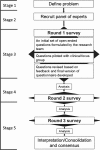Consensus on Hearing Aid Candidature and Fitting for Mild Hearing Loss, With and Without Tinnitus: Delphi Review
- PMID: 25587668
- PMCID: PMC4478070
- DOI: 10.1097/AUD.0000000000000140
Consensus on Hearing Aid Candidature and Fitting for Mild Hearing Loss, With and Without Tinnitus: Delphi Review
Abstract
Objectives: In many countries including the United Kingdom, hearing aids are a first line of audiologic intervention for many people with tinnitus and aidable hearing loss. Nevertheless, there is a lack of high quality evidence to support that they are of benefit for tinnitus, and wide variability in their use in clinical practice especially for people with mild hearing loss. The aim of this study was to identify a consensus among a sample of UK clinicians on the criteria for hearing aid candidature and clinical practice in fitting hearing aids specifically for mild hearing loss with and without tinnitus. This will allow professionals to establish clinical benchmarks and to gauge their practice with that used elsewhere.
Design: The Delphi technique, a systematic methodology that seeks consensus amongst experts through consultation using a series of iterative questionnaires, was used. A three-round Delphi survey explored clinical consensus among a panel of 29 UK hearing professionals. The authors measured panel agreement on 115 statements covering: (i) general factors affecting the decision to fit hearing aids, (ii) protocol-driven factors affecting the decision to fit hearing aids, (iii) general practice, and (iv) clinical observations. Consensus was defined as a priori ≥70% agreement across the panel.
Results: Consensus was reached for 58 of the 115 statements. The broad areas of consensus were around factors important to consider when fitting hearing aids; hearing aid technology/features offered; and important clinical assessment to verify hearing aid fit (agreement of 70% or more). For patients with mild hearing loss, the greatest priority was given by clinicians to patient-centered criteria for fitting hearing aids: hearing difficulties, motivation to wear hearing aids, and impact of hearing loss on quality of life (chosen as top five by at least 64% of panelists). Objective measures were given a lower priority: degree of hearing loss and shape of the audiogram (chosen as top five by less than half of panelists). Areas where consensus was not reached were related to the use of questionnaires to predict and verify hearing aid benefit for both hearing and tinnitus; audiometric criteria for fitting hearing aids; and safety of using loud sounds when verifying hearing aid fitting when the patient has tinnitus (agreement of <70%).
Conclusions: The authors identified practices that are considered important when recommending or fitting hearing aid for a patient with tinnitus. More importantly perhaps, they identified practical issues where there are divided opinions. Their findings inform the design of clinical trials and open up debate on the potential impact of practice differences on patient outcomes.
Figures
References
-
- American Academy of Audiology Task Force. American Academy of Audiology Task Force. Audiologic management of adult hearing impairment. 2006. Staff Publications. Paper 2. Retrieved November 14, 2014, from http://digitalcommons.wustl.edu/audio_fapubs/2.
-
- Avery A. J., Savelyich B. S., Sheikh A., et al. Identifying and establishing consensus on the most important safety features of GP computer systems: e-Delphi study. Inform Prim Care. 2005;13:3–12. - PubMed
-
- Baguley D., McFerran D., Hall D. Tinnitus. Lancet. 2013;382:1600–1607. - PubMed
-
- Biesinger E., Del Bo L., De Ridder D., et al. Algorithm for the diagnostic and therapeutic management of tinnitus. 2011. Retrieved November 14, 2014, from http://www.tinnitusresearch.org/en/documents/downloads/TRI_Tinnitus_Flow....
-
- Blauert J. Spatial Hearing: The Psychophysics of Human Sound Localization. Cambridge, MA: MIT Press; 1997.
Publication types
MeSH terms
Grants and funding
LinkOut - more resources
Full Text Sources
Medical



